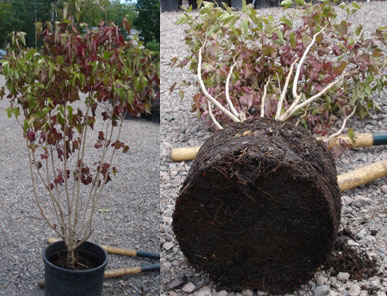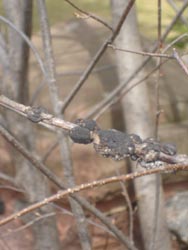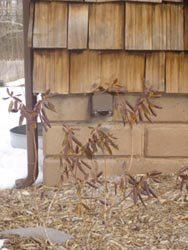|
Trees and Shrubs | Selection | Planting | Maintenance | Problems |
Links to external web pages are followed by the source’s name in parentheses.
Detecting and Diagnosing Problems

What’s wrong with my plant? How can I avoid this problem again in the future? These common questions are the first of many to ask when diagnosing tree and shrub problems. While sometimes the cause of plant problems are obvious (i.e., seeing the deer eat your plants), many problems demand a more lengthy investigation. Diagnosing tree and shrub problems is much like putting a puzzle together. Many pieces need to be gathered and brought together before assembling the finished product.
Fortunately, there is a useful guide for assembling the pieces:
- Diagnosing Plant Damage (Arizona State Extension) is equipped with helpful examples that illustrate the steps in diagnosing plant damage.
Experts agree that it takes practice to diagnose plant problems well. Gathering information about the plant, its problems, and the site requires asking good questions or making good observations. Each diagnostic effort will likely deliver new questions. Remember, there is no one set of good questions to ask, but the following article may be a helpful source for asking diagnostic questions related to trees and shrubs:
- Recognizing tree and shrub diseases (University of Missouri Extension). Notice this article asks many questions in an effort to obtain helpful information to identify the problem. You may want to print this article and use it as a guide for asking questions as part of the plant diagnostic process.
When diagnosing tree and shrub problems, it is helpful to begin with an idea of possible problems that could affect the plant. The following resources are good overviews of problems commonly affecting plants in the landscape:
- Trees and Shrubs: Diseases, Insects, and Other Problems (Sustainable Urban Landscape Information Series, University of Minnesota) is an overview for tree and shrub problems in the landscape.
Sometimes the onset of tree and shrub problems happens quickly, and sometimes woody plants decline gradually over weeks, months, or years.
See:
- Decline and Dieback of Trees and Shrubs (University of Illinois Extension). This report covers symptoms, causes, identification, and control for decline and dieback of trees and shrubs. Note that decline or dieback of trees and shrubs can arise from biotic (living) factors, abiotic (nonliving) factors, or a combination of biotic and abiotic factors. You may notice even when a particular cause of decline is not identified, using good cultural and management practices are essential for reducing the rate of decline or preventing further problems from developing.
Insect and Disease Problems
Insects and diseases are living agents that need nutrition so they, too, can live and reproduce. Sometimes tree and shrub problems caused by insect and disease can be avoided or managed by selecting resistant varieties or maintaining a healthy plant. On the other hand, there are times when insects and disease damage trees and shrubs even when we plan to minimize their opportunities.
Trees and shrubs in the landscape often have to tolerate less than ideal conditions, making them more vulnerable to insects and diseases. The reality is that insects and disease do affect woody plants. Understanding how biotic factors affect trees and shrubs, identifying the causal organism(s), and implementing control strategies are essential in managing tree and shrub insect and disease problems in the landscape.
- Diseases and Insects (Sustainable Urban Landscape Information Series, University of Minnesota) discusses managing insects and disease on plants.
- -Note: Pay special attention to the disease triangle. The disease triangle is central to understanding how insects and diseases are able to affect plants. Read on to find out the differences between the plant disease agents fungi, bacteria, and viruses.
Diagnostic Search Tools
Match tree and shrub insect and disease damage symptoms with the pictures using:
-
University of Maryland, Home and Garden Information Center’s Plant Diagnostic Web site (University of Maryland Extension)
- User hint: Select the tree or shrub type you are investigating (located in the left navigation bar), then select the part of the plant with the problem. When you see the cause that may match the symptoms or signs you are looking for. click “go” to see information regarding the problem and control strategies.
Match tree and shrub disease damage symptoms with pictures and descriptions using:
- An Online Guide to Plant Disease Control (Oregon State University Extension) is a searchable resource for disease.
- -User hint: Do a search by plant name and see which disease problems are associated with the plant you chose. Thorough explanations of text and pictures are provided for many diseases.
Insect and Disease Resources by Region
Identify tree and shrub insect and disease problems, along with their solutions by looking up resources that most closely match your region of the country.
Abiotic Problems of Trees and Shrubs
Sometimes insects and disease get all the blame for causing tree and shrub problems, but there are many nonliving, or abiotic, causes of plant problems: high temperatures (sunscald), low temperatures (frost damage), drought, flooding, lack of oxygen, lack of sunlight, hail damage, high winds causing plant damage or dessication, air pollutants, deicing salts, herbicide damage, improper planting depth, mechanical injury due to construction damage, lawn mower, vehicles, and animals.
Because the problems listed above are caused by mechanical, environmental/physical, or chemical factors, they are not spread from affected plants to healthy plants. As such, abiotic problems are often called noninfectious diseases. Despite the fact abiotic factors weaken, stress, or kill plants, they have no means of spreading to unaffected plants.
Many times damage symptoms to plants from abiotic factors may resemble that of insects or infectious diseases. Sometimes biotic factors must be ruled out to assume abiotic factors caused the problem. Other times, careful review of the timing of particular events or conditions present at a site will help conclude that abiotic factors are the cause of the problem.
Guides and Information
The following provide useful information for diagnosing abiotic problems of trees and shrubs:
- Environmental Stresses and Tree Health (University of Nebraska Extension). This publication provides examples of problems caused by environmental stresses or nonliving agents and control measures for avoiding these problems altogether.
Some of the problems mentioned in the guide above, can be reviewed in further detail through the following:
Stem Girdling Roots
Also known as SGRs, is a noninfectious disease that can lead to tree health decline and premature death. SGRs are preventable and sometimes manageable. The following article provides answers to how they occur and what you can do to prevent them:
- A Practitioner’s Guide to Stem-Girdling Roots (University of Minnesota Extension and USDA Forest Service).
Construction Damage
Construction damage is sometimes a cause of decline in trees and often avoidable. See what you can do to prevent or mitigate construction damage:
- Protecting Trees from Construction Damage: A Homeowner’s Guide (University of Minnesota Extension).
Winter and Storm Damage
- Protecting Trees and Shrubs against Winter Damage (University of Minnesota Extension).
- Storm Damage to Landscape Trees: Prediction, Prevention, Treatment (Department of Forest Resources, University of Minnesota Extension).
Animal Damage
- Coping with Deer in Landscapes (University of Minnesota Extension).




